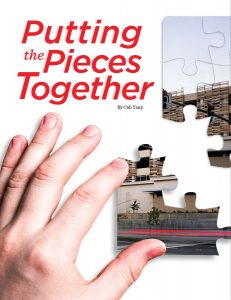By Cali Yang
A winning combination of features makes a transit-oriented development work.
THE WALNUT CREEK TRANSIT VILLAGE IN WALNUT CREEK, CALIF., is an urban mixed-use development that includes studio apartments, retail, restaurants, and public plazas. This is one of the first of many new Transit Villages being planned by Bay Area Rapid Transit (BART). The new South Garage is a five-level, 920-space structure that serves residents, visitors, and BART patrons and features artwork installations created by an award-winning artist.
Putting the Pieces Together
The garage is developed on an existing surface lot and involves access and traffic circulation improvements, including a BART patron kiss-n-ride drop-off, landscaping, and a 2,200 square-foot, single-story BART police building.
The garage is developed on an existing surface lot and involves access and traffic circulation improvements, including a BART patron kiss-n-ride drop-off, landscaping, and a 2,200 square-foot, single-story BART police building. The police facility includes administrative offices, a locker room with restrooms, kitchen and dining area, and detention and interview rooms. Included in the project scope are enhanced bike and pedestrian paths and a bus facility expansion with 15 new bus bays for the Central Contra Costa Transit Authority. Other features include a car counting system, provisions for electric-vehicle (EV) charging stations, and bioretention planters in the bus area that collect rainwater from the rooftop.
Location
The Walnut Creek Transit Village is a premier lifestyle center being developed in two phases. With direct connection to BART, commuters can easily access various forms of transportation that connect to the entire Bay Area and its major businesses, attractions, and airports. Also located near the Transit Village is the Iron Horse Regional Trail, which offers pedestrians, bicyclists, and horseback riders a safe thoroughfare.
The project is located at an extremely busy commuter intersection: Ygnacio Valley Road and the exit ramps of I-680 and CA-24. The early involvement of onsite construction and design team members provided a coordinated site logistics and construction management plan. The plan meets the requirements of the City of Walnut Creek and BART and maintains no impact to BART patrons and commuter traffic during peak times. The logistics plan was circulated to all team members and trade partners to help create transparency on the requirements of the plan and led to an efficient delivery and pickup schedule without any effects on the project.
Features
The purpose of the Transit Village is to create a gateway to Walnut Creek’s downtown core and integrate with the city and surrounding communities. The complex features an active street level with public plazas, central paseo, and a hub to encourage residents and visitors to ride public transportation. The garage can be easily accessed by two vehicular entry points and features dynamic wayfinding signage that displays availability of parking for the new and existing parking facilities. In keeping with the city’s public arts master plan, the garage features several Dan Corson sculptures and art installation pieces mounted to the facade facing the BART station and trackway. Because the Transit Village is a priority public art site, special design features were included with the vision of the garage to ensure the facade was aesthetically complementary to the surrounding neighborhood and future buildings.
The parking facility also features 15 bus bays to accommodate Contra Costa County regional transit buses and the Walnut Creek Trolley Bus. The city trolley buses are powered by electric induction motors for which the parking facility provides two charging pads.
The kiss-n-ride patron drop-off is a beautifully landscaped zone to the north of the existing parking structure. This amenity was a relocation of an existing patron drop-off adjacent to the BART station entrance. The zone includes enhanced lighting and pavement materials, as well as seating for BART patrons awaiting pick-up. This kiss-n-ride is also the newly established location for all ride-share pick-ups and drop-offs to the station.
Challenge
The parking garage was developed in stages to minimize effects on existing BART operations, as well as pedestrian and vehicular access to the existing facilities. This included permitting make-ready work so all of BART’s services could be maintained in operation uninterrupted, relocation of the patron drop-off, and rerouting of the storm drainage of the existing garage to conform to current state requirements. The project program also included the requirement to tie the new facilities into the existing BART infrastructure. An example of this was that the new police facility had to have direct communication from the new facility and could not be tied into or routed through the garage systems. The challenge was that the new garage was between the new police building and the transit station and existing parking structure, which required separate routing of all communication and power feeds to the station, as well as emergency power connections to the existing parking facility generator. This equipment needed to be coordinated and installed without disruption to existing facilities while avoiding the new south garage project.
New overhead high-voltage lines needed to be channeled within the existing parking facility, then out and around the south garage, as well as communication trenching through existing pedestrian plazas and fare gate locations without disruption to ongoing operations. These were very difficult challenges as BART is heavily used at this location and has stringent requirements for work hours and measures for meeting patron expectations.
CALI YANG is marketing manager with International Parking Design, Inc. She can be reached at cyang@oc.ipd-global.com.
